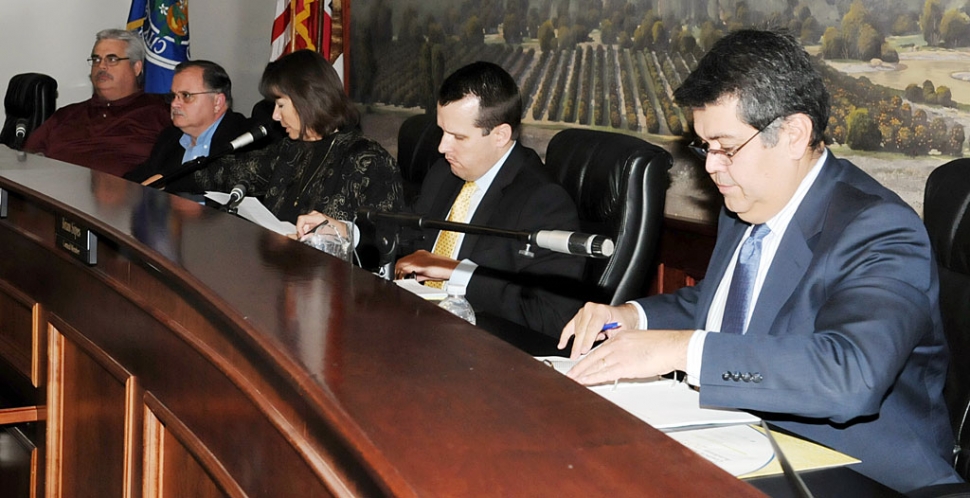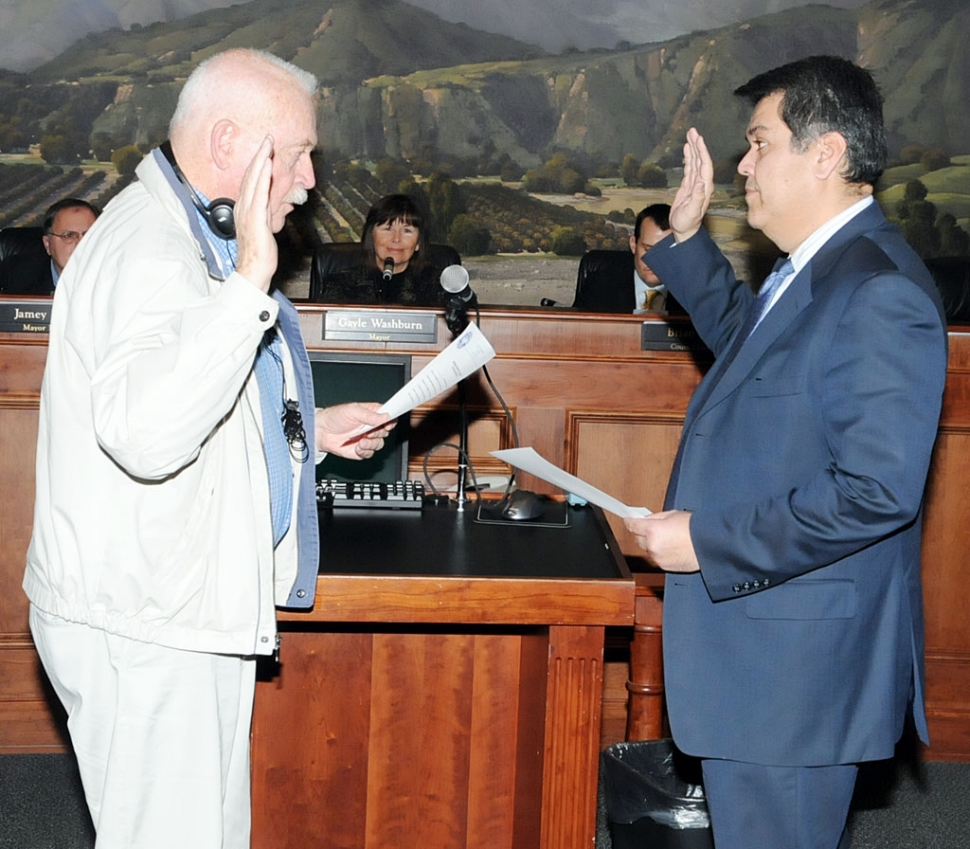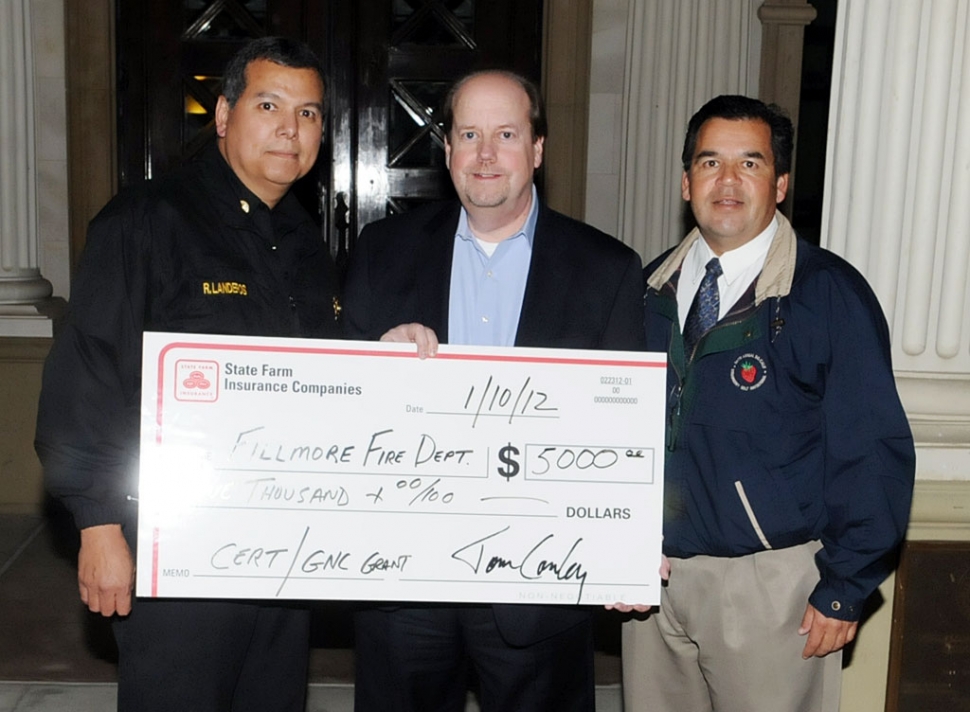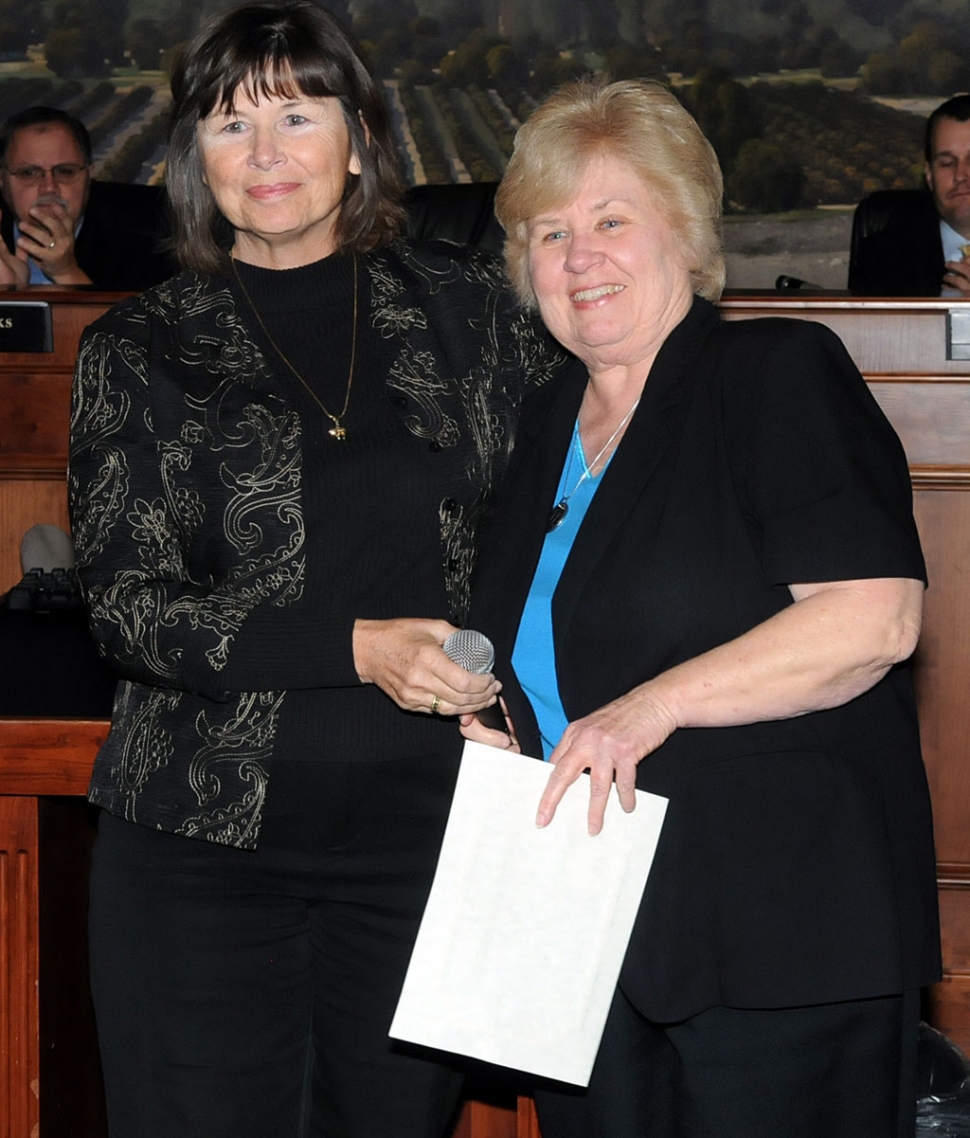|
Gonzalez appointed to replace Walker
 Newly appointed councilmember Eduardo Gonzalez takes his seat at the dais. By Jean McLeod — Wednesday, January 11th, 2012
 City Clerk Clay Westling swears in councilmember Eduardo Gonzalez.  Fillmore Fire Chief Rigo Landeros, State Farm Public Affairs Official Greg Sherlock, and Asst. Fire Chief Bill Herrera hold a $5,000 check, presented to the Fillmore Fire Dept. for the C.E.R.T. program and equipment and training. The grant was presented by State Farm Insurance.  Mayor Gayle Washburn thanks Glenda Jay for exemplary efforts at city hall. Two important items were on the January 10, 2012 Fillmore City Council’s agenda. One was the decision of who would fill the vacant council seat left when Councilmember Patti Walker resigned. The second was what to do with the Fillmore Redevelopment Agency after the recent California Supreme Court decision upheld legislation that abolished redevelopment agencies throughout the State. There were four applicants vying for the seat on the Council. They included Alex Mollkoy, Adrian Grimaldo, Eduardo Gonzalez and Barbara Cavalli. One by one the four applicants were given 20 minutes to answer four predetermined questions and one additional question chosen by each Councilmember. The four standard questions asked were; Why do you want to be appointed to the City Council? What do you see as the biggest challenges facing the City of Fillmore in the next year or two? What do you feel needs to be done to maintain and enhance the City’s economic health? What approach would you take as a Councilmember to balance the budget or address budgetary issues? The additional questions asked were whether the candidate could commit to the time needed to serve and complete the term, leadership, if the applicant could put aside their self-interest, why the Council members should support them, and what the candidate wanted to comment on that the Council hadn’t covered. Cavalli responded to the question of why she wanted to sit on the Council by stating her love for the City and her ability to make level-headed decisions. Gonzalez answered the question with his education and business experience having done hundreds of budgets. Grimaldo’s answer was, “I’m young and not afraid to say what’s on my mind.” Mollkoy answered with, “I have a strong desire to serve the community.” Each Councilmember then gave their opinion on who had impressed them, when Councilmember Jamey Brooks quickly motioned that Gonzalez be appointed to which Mayor Gayle Washburn seconded. There was a pause and the other two Councilmembers Steve Conaway and Brian Sipes said they wanted more discussion with Conaway motioning for Mollkoy to be nominated, but no one would second Conaway’s motion. Then in a 3 to 1 vote with very little discussion, Washburn, Brooks and Conaway voted to give the seat to Gonzalez; only Councilmember Brian Sipes voted against it. The second big item on the agenda was whether the City should become a “Successor Agency” to the Fillmore Redevelopment Agency. In a presentation City Manager Yvonne Quiring gave the pitfalls that the City may face if it decides to give control of Fillmore Redevelopment assets to the State and relinquish control. Quiring informed the Council that the State requires cities to meet enforceable housing units and there would not be any money if housing responsibility went away. Also that the State legislation regarding this component was not well written and contains conflicting provisions. This legislation did not go over well with the RDA’s throughout the State and on July 18, 2011 the California Redevelopment Association and the League of California Cities filed a suit with the California Supreme Court arguing that Proposition 22, which was passed by California voters, prohibited the Legislature from eliminating the roughly 400 RDA’s and the State from using RDA funds. On December 29, 2011 the California Supreme Court ruled on the suit and found that ABX126, which dissolved the RDA’s, did not violate Prop 22 and was a valid exercise of the Legislature’s authority stating that because the State Legislature authorized the creation of the RDA it has the power to eliminate them. And in an opposite decision in that same suit, the court also ruled that ABX 127 asking for the “ransom” did violate Proposition 22. Each Successor Agency will be under the jurisdiction of an oversight board and must put together a payment schedule for the RDA’s liabilities/obligations which must then be signed off on by the county auditor-controller and finally the State Finance Department. The RDA’s will be audited to determine the amount of tax-increment revenue that each RDA had been collecting and any property tax funds remaining after repayment of debt will be distributed to local government agencies in proportion with their usual share under state law. The Successor can receive funds of no less than $250k for administrative costs or up to 5% of property tax for 2011-2012. It is not known at this time if there will be any more layoffs due to this new predicament the City finds itself in. The RDA is very meshed into the workings of the City and handled by many of Fillmore City staff, from Account Clerk to the Finance Department and City Manager. What is considered an “obligation” may also come into question. Projects and loans approved in 2011 by RDA’s will be in limbo until there is a clearer understanding of of the definition of “obligation”. After listening to the presentation, Brooks responded, “We don’t have a choice.” In other business, Conaway asked that the Council discuss the terms of the City Manager’s contract which is set to automatically renew for two more years employment. Sipes asked if this practice was done in the past with other City Managers and Conaway responded, Yes. Sipes then said that going back to his notes he saw nothing like that happening. Conaway then reminded Sipes that none of the other contracts contained an automatic renewal clause. Washburn, Brooks and Gonzalez stated, “I do not support a review.” Conaway then went on to remind the other Councilmembers that if it is not reviewed or considered, the City Manager’s contract will automatically extend for another two years. The other members were fine with that. |
